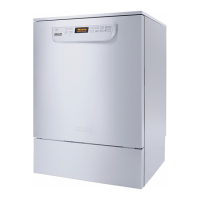Powered by TCPDF (www.tcpdf.org)
MUW216743-2 11
2. Press the yellow button on the salt reservoir with the
symbol on it, in the direction of the arrow. The ap will
spring open.
3. Lift up the funnel.
4. The reservoir takes approx. 1.4 - 2 kg of salt, depending
upon how much is left in.
5. Add salt only until the funnel of the salt reservoir is full,
so that it can close properly. Do not add more than 2 kg
of salt.
6. As the salt reservoir is being lled, displaced water (saline
solution) may run out.
Water softener
31
Filling the salt reservoir
Use only special, coarse-grained reactivation salt with a granule size
of approx. 1 - 4 mm.
Do not under any circumstances use other types of salt such as table
salt, agricultural or gritting salt. These may contain insoluble additives
which can impair the functioning of the water softener.
Inadvertently filling the salt reservoir with cleaning agent will
cause serious damage to the water softener.
Before filling the salt container make sure that you have picked up
the right packet of reactivation salt.
Open the door to an angle of approx. 45°. This ensures that the salt
flows into the reservoir more easily.
Press the yellow button on the salt reservoir with the symbol on
it in the direction of the arrow. The flap will spring open.
Lift up the funnel.
The reservoir takes approx. 1.4 - 2 kg of salt, depending on the type
of salt and how much is left in.
7. Clean any excess salt from the area around the salt
reservoir and especially from the seal using Eschmann
recommended wipes. Do not use running water as this
can cause the salt reservoir to overow.
8. Close the funnel and the ap.
9. Run the Rinsing programme after relling salt. This will
ensure that any traces of salt and saline solution are
dissolved and rinsed away.
Add Salt reminder
If the salt level in the reservoir is low, the following reminder
will appear.
Conrm the message with the OK button and ll the
reservoir as described.
The message may reappear, but it will stop soon once the
salt has dissolved
3.3. Adding & Dispensing Chemicals
Dosing of Chemicals
This machine uses two types of chemical, a cleaning agent
that is used to clean the instruments, and a rinse aid used in
the nal rinse (disinfection stage) to prevent water residues
clinging to the instruments and allow better drying.
The chemicals used form part of a UK validated system of
cleaning instruments. Using other types or dierent volumes
may prevent cleaning or cause issues with your instruments
or the machine itself (Only use validated chemicals). Refer to
Appendix 4 for chemicals.
Dosage volumes are pre-set by an Eschmann engineer as
part of the cycle validation and ongoing testing. This machine
will always use liquid chemicals for cleaning, as this protects
delicate devices during processing (Powder chemicals are
not suitable and should not be used).
- CAUTION
POSSIBLE EQUIPMENT DAMAGE
Use only chemicals that are suitable for washer
disinfectors. Do not use chemicals for domestic
dishwashers as they will not clean eectively.
Water softener
33
Add salt reminder
If the salt level in the reservoir is low, the following reminder will
appear:
Refill salt
Confirm the message with the OK button and
fill the reservoir as described.
When the message first appears, there may be sufficient salt for a
further programme, depending on the water hardness level set.
If there is no saline solution left in the water softener, a relevant
message will appear in the display and the machine will be locked
for further use.
The machine can be used again a few seconds after the salt has
been refilled.
WARNING!
EQUIPMENT DAMAGE HAZARD
DO NOT ll the reservoir with water.
The reservoir could overow when lled with salt.
- CAUTION
POSSIBLE EQUIPMENT DAMAGE
Salt and saline solution which has overowed can
cause corrosion damage if not rinsed away.

